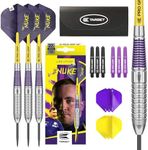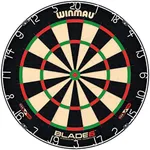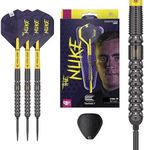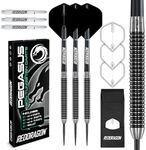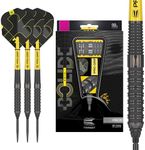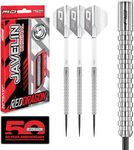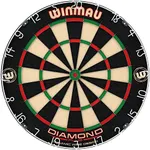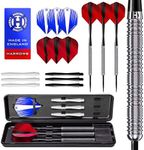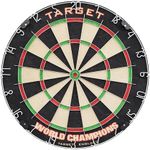Buying Guide for the Best Professional Darts
Choosing the right professional darts can significantly impact your game. The right set of darts will feel comfortable in your hand, suit your throwing style, and help you achieve better accuracy and consistency. When selecting darts, consider factors such as weight, material, grip, flight shape, and shaft length. Understanding these key specifications will help you make an informed decision and find the best fit for your playing style and preferences.WeightThe weight of a dart is crucial because it affects how the dart flies and how it feels in your hand. Darts typically range from 12 grams to 50 grams. Lighter darts (12-20 grams) are easier to throw with more speed and are often preferred by players with a faster throwing style. Medium-weight darts (21-25 grams) offer a balance between speed and control, making them a popular choice for many players. Heavier darts (26-50 grams) provide more stability and are favored by players who prefer a slower, more deliberate throw. To choose the right weight, consider your throwing style and try out different weights to see which feels most comfortable and improves your accuracy.
MaterialDarts are made from various materials, including brass, nickel-silver, and tungsten. Brass darts are affordable and suitable for beginners, but they wear out quickly. Nickel-silver darts are more durable and offer better performance than brass. Tungsten darts are the most popular among professional players due to their high density, which allows for thinner barrels and tighter groupings on the dartboard. Tungsten darts are more expensive but provide superior durability and performance. If you're serious about improving your game, investing in tungsten darts is a wise choice.
GripThe grip of a dart refers to the texture and feel of the barrel. Grips can range from smooth to heavily knurled or ringed. A smooth grip allows for a quick release but may be harder to control, especially if your hands get sweaty. A heavily knurled or ringed grip provides more control and prevents slipping but may feel too aggressive for some players. The right grip depends on your personal preference and how you hold the dart. Experiment with different grip styles to find one that offers the best balance of comfort and control for your throwing technique.
Flight ShapeThe shape of the dart flight affects the dart's stability and trajectory. Standard flights are larger and provide more stability, making them suitable for players who throw with less force. Slim flights are smaller and create less drag, making them ideal for players with a faster, more powerful throw. There are also other shapes like pear, kite, and teardrop, each offering different levels of stability and drag. To choose the right flight shape, consider your throwing speed and style. Trying out different shapes can help you find the one that enhances your accuracy and consistency.
Shaft LengthThe shaft length of a dart affects its balance and flight path. Shorter shafts (35mm or less) make the dart more front-heavy, which can help with a more direct throw. Medium shafts (35-50mm) offer a balanced feel and are the most commonly used length. Longer shafts (50mm or more) make the dart more back-heavy, which can help with a more arched throw. The right shaft length depends on your throwing style and how you prefer the dart to feel in your hand. Experimenting with different lengths can help you find the one that provides the best balance and control for your game.
